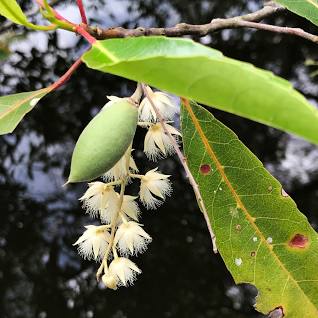Rudraksha - Utrasum bean tree

Elaeocarpus angustifolius
Summary
Scientific Classification
Kingdom: Plantae
Division: Angiospermae
Class: Magnoliopsida
Order: Oxalidales Family: Elaeocarpaceae Genus: Elaeocarpus
Species: Elaeocarpus angustifolius
Scientific Name: Elaeocarpus angustifolius Bl.
Common names
English: Blue Fig, Blue Marble Tree, Blue Quandong, utrasum bean tree
Hindi: Rudraksha
Marathi: Rudraksha
Sanskrit rudrākṣa, meaning “Rudra’s teardrops” or “eyes”
Description
Elaeocarpus angustifolius is a tree that typically grows to a height of 40 m (130 ft) and usually has buttress roots at the base of the trunk. The leaves are about 60–180 mm (2.4–7.1 in) long, 40–60 mm (1.6–2.4 in) wide with wavy serrations on the edges and tapering to a petiole 5–15 mm (0.20–0.59 in) long, but lacking a pulvinus. Old leaves often turn bright red before falling. The flowers are arranged in racemes up to 100 mm (3.9 in) long, each flower on a pedicel 9–16 mm (0.35–0.63 in) long. The five sepals are 8–11 mm (0.31–0.43 in) long and 1–2 mm (0.039–0.079 in) wide. The five petals are creamy white, egg-shaped to oblong, 12–15 mm (0.47–0.59 in) long and 3–4 mm (0.12–0.16 in) wide, the tip with linear lobes. There are between thirty-five and sixty stamens and the style is 11–18 mm (0.43–0.71 in) long and glabrous. The fruit is a more or less spherical, bright blue or purple drupe 15–23 mm (0.59–0.91 in) in diameter. Note, however, that Coode considered E. grandis to be the same species as E. angustifolius, and the above description applies to both taxa.[11]
Mature trees will grow massive buttresses which generally completely encircle the base of the trunk. This may be an adaptation to becoming emergents in some habitats, or often growing in secondary woodland -buttress roots can better distribute tensile stress in the base of the tree transmitted down from wind in the crown. In E. angustifolius the buttresses are thought to develop in response to stresses experienced by the tree during comparatively brief periods of fast development. The buttress wood has a partially different composition than the wood of the trunk.
 Trees of Empress Botanical Garden - Project supported by
Trees of Empress Botanical Garden - Project supported by